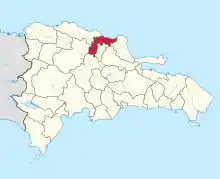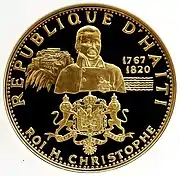Massacre of Moca, Santo Domingo
The Beheading of Moca (Spanish: Degüello de Moca; Haitian Creole: Masak nan Moca; French: Décapitation Moca)[2] was a massacre that took place in Santo Domingo on April 6, 1805. The event was narrated by survivor Gaspar Arredondo y Pichardo in his book Memoria de mi salida de la isla de Santo Domingo el 28 de abril de 1805 (Memory of my departure from the island of Santo Domingo on April 28, 1805), which was written shortly after the massacre.[3] This massacre is part of a series of Haitian invasions[4] to Santo Domingo and is part of Siege of Santo Domingo (1805). Haitian historian Jean Price-Mars wrote that the troops killed white, black and mixed inhabitants of Santo Domingo. This event has been presented in Haiti as a fight against slavery.[5]
| Beheading of Moca | |
|---|---|
| Part of Siege of Santo Domingo (1805) | |
 | |
| Location | Santo Domingo |
| Date | 6 of April, 1805 |
| Target | Jean-Louis Ferrand and his troops, Dominicans. |
Attack type | Massacre, Genocide |
| Weapons | Bayonets, machetes, axes, firearms |
| Deaths | 500 (in one day).[1] 5 municipalities burned to the ground. |
| Perpetrators | Armed Forces of Haiti |
The raids, carried out by 40,000 Haitian soldiers,[6] were headed by Henri Christophe and Jean-Jacques Dessalines, who were present during the action. Municipalities of Santo Domingo (Monte Plata, Cotuí, La Vega, Santiago and Moca) were reduced to ashes and troops killed Dominicans, including 40 children who were beheaded in a church, during a failed attempt to overthrow Jean-Louis Ferrand. Ferrand was later overthrown on November 7, 1808 after the defeat in the Battle of Palo Hincado, that definitively put an end to the presence of any French rule on the island.[7]
The inhabitants of the Spanish-speaking side of the island inherit the Dominican national name, which is derived from the country Santo Domingo, since the early 17th century.[8]
Events

These events were narrated in the accounts of witness Gaspar de Arredondo y Pichardo, a young law student living in Santiago, Santo Domingo, who later fled to Cuba after surviving the genocide. Dessalines's intended targets were Ferrand and his French soldiers, but he had also warned the Dominican inhabitants in a letter to cooperate with him or risk death. Gaspar de Arredondo y Pichardo details his account of the events in the book Recuerdo de mi salida de la isla de Santo Domingo el 28 de abril de 1805 (Memory of my departure from the island of Santo Domingo on April 28, 1805), which was discovered in Cuba and then handed over to the Dominican government for historical record.[3]
Haitian troops entered the cities and killed everyone they encountered, whether they were white, mixed or black.[5] Some of the stories:

- The Haitian (troops) entered the city like a fury of hell, cutting their throats sword in hand, trampling everything they found, and making blood run everywhere. Imagine what would be the consternation, terror and fright that that neighborhood, so neglected, fell silent for a moment, in view of similar events, when almost everyone was gathered in the main church, with their pastor imploring divine help, while it represented on the altar the sacrifice of our Redemption, and in readiness to receive communion, as one of the days of the year in which, by custom, even those in the country came to fulfill the annual precept. The throng of women fleeing without knowing where. The screams of children and the elderly who came out of their houses in terror. The ecclesiastical confused in the midst of those who asked him for comfort. – de Arredondo y Pichardo.[3]
A well-known mestizo tailor named Fernando Pimentel is mentioned in (44):
- A man (44), who had not yet swallowed the sacramental species, was passed with a bayonet and was left lying at the door of the same sanctuary. From there, whoever was able to escape later fell into the hands of the army (Christophe's army) who roamed the city and did not spare any life they encountered. All obeyed, believing that some pardon or grace was going to be proclaimed in their favor, but the pardon was to slaughter them all after the meeting like cornered sheep. The Haitian (troops) after consummating the frightful, sacrilegious and barbarous sacrifice, left the town: that of all the women who were in the church, only two girls were left alive who were under the corpse of the mother, the aunt or the person who accompanied them, they pretended dead because they were covered with the blood that had spilled the corpse they had on top that in the presbytery. There were at least 40 children with their throats slit and on top of the altar a lady from Santiago, Mrs. Manuela Polanco, a woman from Don Francisco Campos, a member of the Departmental Council, who was sacrificed on the day of the invasion and hung on the arches of the Town Hall, with two or three mortal wounds from which he was dying. – de Arredondo y Pichardo.[3]
The Haitian troops returned to Haiti after noticing French ships they thought were heading towards the western part of the island, which they believed were being sent to attack their country. Gaspar de Arredondo y Pichardo also relates that, in the retreat to Haiti, all the cities crossed and the population were reduced to ashes, even altars.[9][3]
The Otsego Herald newspaper, based in Cooperstown, New York, published details of the massacre on the same month:
- Haytian army had gone against Santo Domingo. They were said to amount to 40,000 men. Dessalines, the Emperor, had marched at the head of these until they reached Santiago, an inland town of considerable strength. A council of war was then held, when it was determined to storm the city. The Emperor, however, was requested not to risk his life in the attempt. The direction of the siege was given to General Brave, who, after a desperate and bloody conflict, succeeded in carrying the city; not, however, without considerable loss – It was rumored that General Brave was mortally wounded and had lost 1,000 of his best troops. The French and Spaniards found in the city, it was supposed, were all put to the sword. – Otsego Herald newspaper, April 25, 1805[6]
Effect

This massacre has been linked to the 1937 massacre in the Dominican Republic, and is seen as a contributor to the events that culminated during the regime of the future president Rafael Leónidas Trujillo to order that massacre.[10]
The slaughter of the innocent and the burning of municipalities left a negative impression from the Dominican Republic about the intentions of Haiti, which later invaded Republic of Spanish Haiti during the Ephemeral Independence in 1822 after an unresisted invasion with the force of an estimated 10,000 of Haitian troops commanded by Jean-Pierre Boyer to unify the country with Haiti.[4] Veteran Haitian history writer Jan Rogoziński quantified the population of Santo Domingo declining to 63,000, in 1819, due to attacks like Beheading of Moca. The Dominican population numbered 125,000 in 1789.[11]
The history of Haiti presents these massacres as necessary events to ensure the independence of its country for fear of the reestablishment of slavery throughout the island at that time, due to the intentions of Jean-Louis Ferrand. They praise the attacks made against French troops whose intentions were to restore slavery that was abolished in Haiti years earlier.[5]
In popular culture
Recognized in The Feast of the Goat – A novel book by peruvian writer Mario Vargas Llosa.
See also
References
- "El Degüello de Moca". Santo Domingo, RD: Diario Libre. 2014.
- Temboury, Francisco Javier (2016). El habla de Santo Domingo. Punto Rojo Libros S.L. p. 158. ISBN 978-8-416-97902-8.
- Arredondo y Pichardo, Gaspar de (2008). Memoria de mi salida de la isla de Santo Domingo el 28 de abril de 1805.
- Rodríguez Demorizi, Emilio (1955). Invasiones haitianas de 1801, 1805 y 1822. Editora del Caribe.
- Price-Mars, Jean (1953). La República de Haití y La República Dominicana (PDF).
- "Domestic Herald". Otsego Herald. 25 April 1805.
- Southley, Captain Thomas (1827). Chronological History of the West Indies. p. 421.
- Balcácer, Juan Daniel (2012). "Acerca del gentilicio de los dominicanos". Santo Domingo, RD: Diario Libre.
- Valenzuela, Roberto (May 7, 2018). "Haitianos cometen matanza en Moca" (in Spanish). Santo Domingo, RD: El Nuevo Diario.
- Lantigua, José Rafael (2019). "El degüello de Moca". Santo Domingo, RD: Diario Libre.
- Rogoziński, Jan (1999). A Brief History of the Caribbean. p. 221.